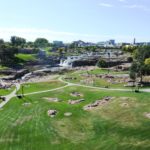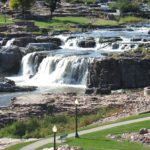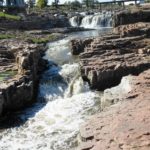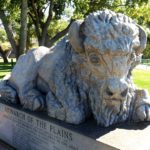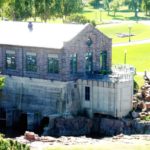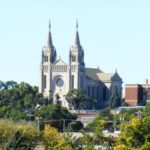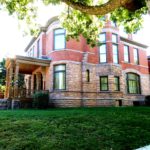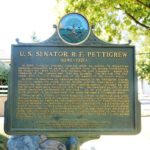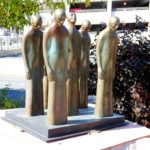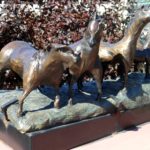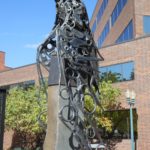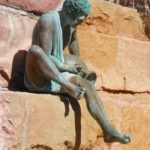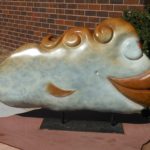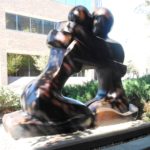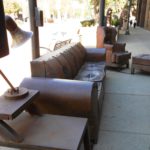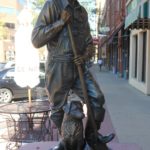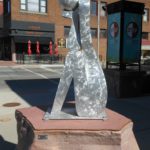We made a pit stop half way across SD and arrived in Sioux Falls on Tuesday. This was one of two metropolises (metropoli ?) in South Dakota that we’d missed on The Journey — the other being Pierre, the Capitol. So a third trip is in the offing in the future.
The campground was strange but decent. It was off a city street, but a barrier of buildings kept it quiet and it was nicely wooded. The clientele was overwhelmingly a caravan of transient workers — more than 30 families, from Alabama and Mississippi, traveling in a group with identical “park model” trailers that looked more like mobile homes. One morning, about half way through our week’s stay, they all disappeared in a convoy, leaving behind toys and bikes and outdoor furniture and piles of trash that imposed a massive cleanup project on management.
It took several trips downtown to see everything we wanted to. The first took us to Falls Park, a giant oasis on the North side that’s dressed up for the tourist crowd. The Visitors Center has a fifty foot high observation tower that provides a birds-eye view of the Falls — Lower, Middle and Upper. From the Center,’s tower, we strolled down for a closer look and to take in some of the neighboring sites. Monarch of the Plains was carved from a 12 ton piece of mahogany granite that came from Milbank, SD, 125 miles due north. It was carved in 1999 by Darold Bailey. The Sioux Falls Light and Power Company, in service from 1908-1974 is now the Overlook Café, with indoor and outdoor dining. Below the power plant were the ruins of the Queen Bee Mill, a brainchild of Richard Pettigrew, one of SD’s first US Senators. It was built so local farmers could process their wheat locally, rather than sending it east to Minnesota or Wisconsin. It went bankrupt after just two years of operation (1881-83), but it then changed hands and continued to process until the mid 1910’s. A Millrace and Dam supplied water power to both the mill and the power plant. Looming over all from across the Lower Falls is St Joseph’s Cathedral.
- Falls Overview
- Closer View
- One of numerous raceways
- Monarch of the Plains
- The Power Company, now the Overlook Cafe
- St. Joseph’s Cathedral
The Cathedral lends its name to the Historic District, a collection of about forty buildings in a 20 square block area. As is our usual habit, we drove through it, reading a syllabus as we passed each home. The tour was interesting but not particularly memorable! We did visit one building – the Richard Pettigrew Home and Museum. Senator Pettigrew built a home for his new bride in 1880 just two doors away. He sold it in 1912 to buy this 1889 Queen Anne from attorney Thomas McMartin and expanded it extensively prior to his death in 1926. When it accrued to the city, they expanded it even further to house more artifacts.
- The Pettigrew Home
- The Pettigrew Story
Another downtown trip was a self-guided tour of Sculpture Walk. We first saw such an attraction in Salina, Kansas, but this one was far more expansive. Fifty five sculptures are placed on the sidewalks throughout uptown and downtown. Each is labeled with its title and artist name, as well as the sponsor’s name. The brochure/ballot also notes the location and the selling price. This is the tenth year, and the city buys the winner of the People’s Choice voting. All past winners, along with two dozen other works either owned or leased by the city, are displayed as well. We didn’t get to visit all of this treasure trove, but relative samples are below to show you the diversity of the collection. The photos are worth enlarging!
And I went for a little extra culture. The Sioux Falls Symphony Orchestra performed Mahler’s Ninth Symphony on the Saturday before we left, and their performance was excellent. Only one downside: the maestro came out and spent about ten minutes talking about the work. I could do without this. This also happened at a symphonic performance I went to in Moab. Just music, please. I can read the program notes!
We were now in the home stretch, with Iowa our next stop.

